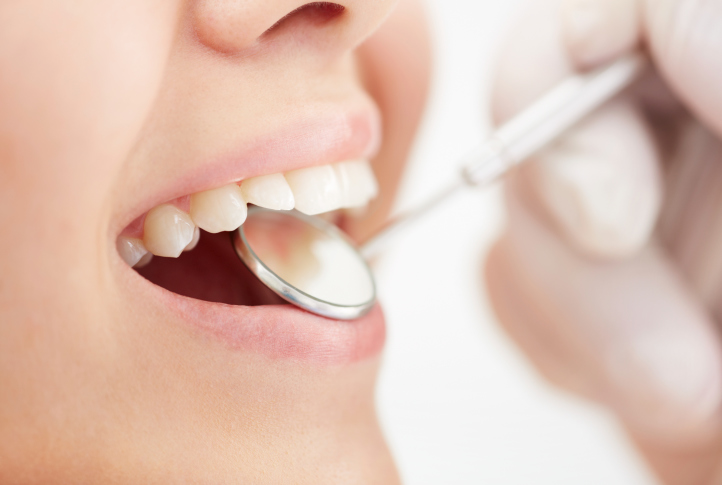Uncategorized
Diabetics Must Work Harder to Maintain Their Oral Health
If you suffer from diabetes, managing your blood sugar levels isn’t the only thing you’ll need to work harder at in order to stay healthy. Individuals with diabetes also have a higher risk of suffering from oral health problems due to the disease’s ability to impact how effectively your body fights harmful bacteria that grows in the mouth known as plaque.
High blood sugar levels in the body encourage the growth of plaque, which can eventually lead to gum disease if left to thrive on your teeth and gums. You may already suffer from gum disease if you have:
- Red, bleeding, swollen, or sore gums, or gums that have begun recede away from the base of your teeth.
- Chronic bad breath
- Loose teeth
- Ill-fitting dentures or an irregular bite
Fortunately, patients of Portland dentist Dr. Howard Jarvis with diabetes can still successfully manage their oral health by taking a few extra precautions.
Control Your Diabetes
Gingivitis and diabetes feed off each another to make both diseases worse for diabetics who don’t have their condition under control.
Poorly controlled blood sugar levels increase your risk of developing oral health conditions such as tooth loss, dry mouth, gum disease, and fungal infections like thrush. Gum disease, such as gingivitis or the more serious periodontitis, and thrush can lead to an oral infection. Diabetics with an infection have an even harder time controlling their blood sugar levels, which in turn makes them more likely to develop an oral infection.
To keep your mouth healthy and prevent infections, you need to have your diabetes under control.
Schedule Regular Dental Visits
Since individuals with diabetes have a higher likelihood of developing an oral infection, you need to schedule regular appointments with a dentist. Make sure to inform Dr. Jarvis of your diabetes, and inform him of any medications you take to help control the disease. In addition to providing oral health cleanings that help to protect and strengthen your teeth, Dr. Jarvis can also provide you with tips on how to properly care for your teeth at home as a diabetic. Depending on the current state of your oral health, Dr. Jarvis may recommend scheduling appointments every three months, instead of the usual six.
Practice Quality Oral Hygiene
As mentioned previously, high blood sugar levels encourage the growth of plaque in the mouth. The more plaque your mouth contains, the more acid this bacteria can create whenever you eat or drink sugary liquids. This acid slowly eats away at your teeth’s enamel, eventually causing gum disease and tooth decay.
Since your mouth already creates more plaque naturally, you need to pay close attention to maintaining and practicing quality oral hygiene. This means brushing at least twice a day for two minutes at a time, and flossing daily. You should also consider adding an anti-bacterial mouthwash as part of your nightly oral hygiene routine.
While a matter of personal preference on the type of brush used, studies have shown that electric and sonic toothbrushes help to clean more plaque from teeth than traditional handheld brushes. Individuals with uncontrolled diabetes may want to consider the use of an electric or sonic toothbrush to help combat the additional plaque their mouths creates.
If you have any questions about what diabetes can do to your oral health, feel free to ask your dentist in Portland, Oregon Dr. Howard Jarvis during your next appointment at Southwest Portland Dental.
Understanding the Signs and Symptoms of Oral Cancer
Individuals who suffer from gum disease and other dental ailments have an increased risk of becoming infected with oral human papillomavirus, a sexually transmitted virus that studies have linked to causing between 40 and 80 percent of all throat cancers, according to a recent study.
Those participating in the study that reported having poor oral health experience a 56 percent higher rate of contracting an oral HPV infection when compared to study participants who reported enjoy quality oral health, reported researchers in a study published online in the American Association for Cancer Research journal Cancer Prevention Research.
Oral HPV infections are similar to a genital HPV infection in that both offer high and low-risk variations. Low-risk oral HPV infections can cause non-cancerous tumors or warts in the mouth and throat, while high-risk strands of the virus may cause cancers of both the throat and mouth.
Attempting to avoid infection of either strand of the virus marks just one more reason why individuals should strive to take maintain their oral health, claimed researchers at the University of Texas Health Sciences Center in Houston who conducted the study. Researchers concluded that even after factoring in known risk factors for HPV infection, such as oral sex habits and smoking, poor oral health still ranked as an independent risk factor for oral HPV infection.
Path of Infection
According to researchers, poor oral health increases an individual’s risk of developing problems such as sores in the throat or mouth and gum inflammation that provide HPV viruses easier access to the bloodstream. Individuals who enjoy quality oral health tend to have fewer issues that cause openings to develop in the mouth that increase their risk of contracting HPV.
Despite the early conclusions drawn by this study, researchers cautioned that more study is needed before any a definitive link is drawn between oral health and an increased risk of cancer.
Testing for HPV becomes problematic for researchers as most individuals who infected with the virus have no symptoms, and only a small percentage of those with the virus actually develop cancer, according to data provided by the American Cancer Society. Currently no test for oral HPV has been approved for us in the U.S.
While certain drug manufacturers have developed vaccines that prevent cervical cancer caused by infection from certain types of sexually transmitted HPV strands, none of these drugs have been approved to prevent oral cancer. The Centers of Disease Control and Prevention currently estimate that HPV afflicts four out of every five sexually active individuals during some point in their lives.
Study Examination
As part of the study, researchers examined data of over 3,400 individuals between the ages of 30 to 69 that participated in the National Health and Nutrition Examination Survey conducted by the CDC. The survey asked that participants rate their oral health overall, whether they suffered from known gum disease, had recently undergone any dental procedures, what their daily oral hygiene regimen consisted of, and how many teeth that had remaining.
Researchers discovered that men, marijuana users, smokers, and individuals who had multiple oral sex partners had a higher risk of contracting HPV. Poor oral health had previously been linked to oral HPV infections in additional studies.
The study concluded that individuals who suffered from gum disease had a 51 percent greater risk of contracting HPV when compared to those without gum disease. Participants who experience greater problems with their oral health on average also had a 28 percent risk of infection.
According to the American Cancer Society, approximately 36,000 individuals will develop cancers of the throat and mouth this year in the U.S., resulting in nearly 7,000 deaths.
Oral Cancer Symptoms
Understanding the risk of oral cancer also means knowing the potentials signs and symptoms of the disease. According to the ADA, oral cancers can exhibit such symptoms as:
- Unexplained bleeding in the mouth
- Unexplained numbness or loss of feeling in the mouth
- Persistent sores on the face, neck or mouth
- Problems eating, chewing or swallowing
- Chronic sore throat or trouble speaking
- Significant unexplained weight loss.
If you experience any of the recurring symptoms, it’s important that you schedule an examination with Dr. Jarvis or your primary care physician.
Parents Behavior Can Affect Kids Oral Health
A new study published in the Canadian Journal of Dental Hygiene has brought renewed attention on the existing crisis that exists in children’s oral care and provides a proven method of treatment and behavior modification that has shown success in improving the way kids approach oral hygiene.
In the study, researchers at the DentaQuest Institute reported on the opportunities to increase prevention in dentistry. Researchers noted that nearly 41 percent of the population in the U.S. five years of age and older suffer from some type of untreated tooth decay, according to studies conducted by the Centers for Disease Control and Prevention. Children living in households at or below the U.S. government’s poverty line suffer from the highest prevalence of untreated tooth decay, at just over 25 percent.
Further highlighting the issue at hand, researchers cited a recent study by the Centers for Medicare and Medicaid Services that showed that only 47 percent of kids receiving Medicaid had access to some kind of dental care in 2013.
While researchers acknowledged that Medicaid provided for treatment of oral disease, an opportunity to promote preventative care that would reduce decay and the need for surgery were being missed.
Parent Behavior Can Have Significant Impact
According to researchers, as the knowledge of dental disease and prevention has improved, the opportunities to provide necessary care and preventive intervention has also increased. Researchers then touted a collaborative effort between the DentaQuest Institute and Boston Children’s Hospital to find a way to reduce childhood tooth decay.
The systems used in this collaborative venture to reduce rates of decay included a risk and behavior assessment of parental actions. Citing a 2002 study, researchers noted that when relating to detrimental health behavior, a change in parental behavior can contribute four times more to significant change when compared to medical assistance.
For example, many parents are unaware of the detrimental effects placing juice in sippy cups presents towards their child’s oral health and how it increases the risk of oral decay. By encouraging parents to change this type of behavior, such as by putting water in the bottle at bedtime instead of juice or milk, parents can make a dramatic difference to their children’s oral health.
Additionally, researchers stated that parents can also improve the oral health of older children by leading by example when it comes to practicing quality oral hygiene. By making it a point to brush and floss along with their kids, parents can help lead by example of what it means to practice quality oral hygiene.
Children are far more likely to follow a parents example rather than just do as they are told when it comes to practicing quality oral hygiene, explained researchers. By providing a practical example, parents are far more likely to help establish good oral hygiene habits with their kids.
If you have any questions about your kids oral health please contact your choice for Southwest Portland Kids Dentist: Dr. Howard Jarvis, today
Study Finds Protein Could Help Prevent Gum Disease & MS
In a new study, researchers at the University of Pennsylvania have found a protein previously known to treat gum disease can also block relapses in mice with a condition very similar to multiple sclerosis.
The jump from experiment on gum disease to investigating the effects of this protein, clinically referred to as Del-1, on MS began when researchers discovered that the protein plays a vital role in immune response within the body. Here at Southwest Portland Dental, your Southwest Portland Family dentist of choice, we want to let you know of all the latest in health and dental news.
The Jump from Gums to Brain
In research previously conducted by the team from Penn, researchers had discovered that Del-1 was absent in mice that were exposed to the mouse version of gum disease. This led researchers to being asking why.
The immune system acts as the body’s defense mechanism against foreign invaders. When an invader is detected – whether an insect bite, bacteria, virus, or simple splinter – the immune system goes into action, sending cells to the area of the injury.
Researchers discovered that Del-1 controls how immune cells accumulate and circulate throughout the body. When there are low levels of Del-1 – which was true for the mice suffering from gum disease – the response from the immune system can quickly get out of control. Without the system of checks and balances provided by Del-1, inflammation becomes chronic, which results in damage to gum tissue and underlying bone structure.
When researchers injected Del-1 into the gum tissue of mice, they discovered that the infection cleared. This was a remarkable discovery, and researchers began to consider what implications this could hold for other inflammatory diseases.
When they examined a variety of human tissues for Del-1 expression, they discovered that the brain expressed the most significant amounts of the protein. This suggested to researchers that Del-1 could play a significant role in the central nervous system.
During their study, researchers discovered a genetic study by an independent team that had previously identified Del-1 as a potential risk factor for MS, however there have currently been no additional research that links the protein with the disease.
Del-1 & MS
Researchers examined brain tissue from both individuals with MS and those without the disease. They discovered far lower levels of Del-1 in the brain tissue of individuals suffering from the disease at the time of their death when compared to healthy individuals and MS patients who were in remission from the disease at the time of their deaths. Researchers also noted that mice that were exposed to the MS.-like disease also tested for lower levels of Del-1.
To test their theory about what role Del-1 played on MS, researchers waited for the mice exposed to the MS-like disease to suffer a relapse, a time when protein levels would plummet. After injecting the mice with Del-1, the team noted that the relapses stopped and the mice suffer no more flare-ups.
The results of this study provide researchers with the hope that controlling Del-1 levels could provide health care providers with a tool for combating both gum disease and MS.
Just a Dab Will Do When Brushing Your Kids' Teeth
While a child’s baby teeth eventually fall out and are replaced with permanent teeth, they still play an enormously important role in the long-term development of a child’s oral health. Baby teeth act as space holders that help to guide adult teeth into position once they begin to form. Children who lose their baby teeth at too young an age have an increased risk of suffering from a variety of oral problems, including crooked, crowded, or misaligned teeth. Considering the important role baby teeth play, parents need to take the time and make the effort to clean their kids’ gums after every feeding, and brush their teeth once they emerge after meals.
While the American Dental Association had previously recommended parents use a small amount of toothpaste containing fluoride when brushing their child’s teeth, concerns over excessive fluoride exposure have caused the ADA to revise their recommendation for how much young children should receive.
New guidelines issued by the ADA now ask parents to reconsider how much toothpaste they squeeze onto their kid’s toothbrush in an effort to limit fluoride exposure.
The Risk of Fluoride Exposure
Most dentists typically apply prescription-strength fluoride treatment to patients’ teeth as part of cleanings, as fluoride has been proven to reduce the risk of cavities through a process called re-mineralization. However, for younger patients, fluoride exposure increases their risk of fluorosis, a cosmetic condition that causes teeth to appear brown or spotted.
Fluorosis only occurs when young children receive excessive exposure to fluoride. To limit fluoride exposure, the ADA previously recommended that parents only apply a pea-sized drop of toothpaste to their child’s toothbrush prior to brushing. Since younger children have a hard time not swallowing toothpaste during brushing, the use of a limited amount of toothpaste containing fluoride would reduce the potential exposure. However, the ADA has now reconsidered the appropriate amount of toothpaste parents should use.
A Little Goes a Long Way
Instead of a pea-sized drop, the ADA now recommends that parents use a “smear” of toothpaste when brushing the teeth of children under the age of 3. When a child gets older and can better control his or her reflex to swallow, parents are then once again encouraged to use to a “pea-sized” amount when brushing.
The change comes after the ADA reconsidered how much toothpaste parents needed to use in order to reduce their kids’ risk of tooth decay, while not exposing kids to an increased risk of fluorosis. The ADA now feels confident, however, that a smaller amount of toothpaste will still provide enough protection for kids’ long-term oral health to no longer warrant the risk of excessive fluoride exposure that previously existed under the old guidelines.
If you have any questions about how much toothpaste to use when brushing your kids’ teeth, feel free to ask your family dentists in SW Portland, Drs. Jarvis or Goldwyn during your next appointment.




